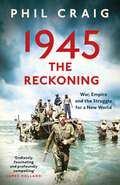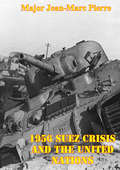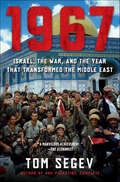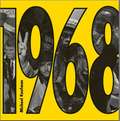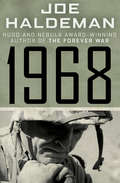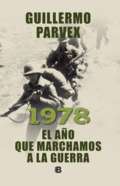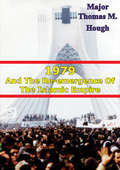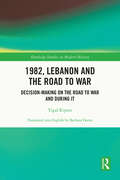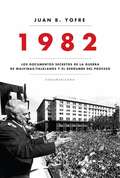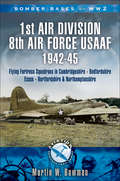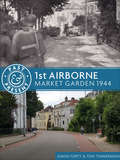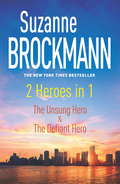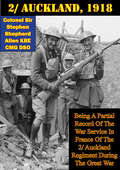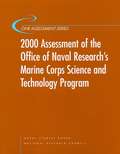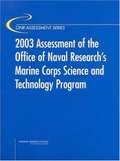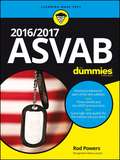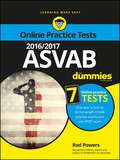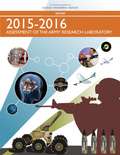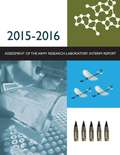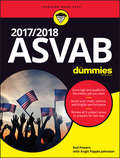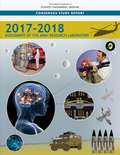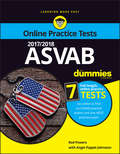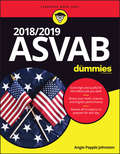- Table View
- List View
1945: War, Empire and the Struggle for a New World
by Phil CraigAs the fate of the world is decided, so too is that of the British, Dutch and French empires. In India a generation committed to independence must decide whether to support 'the Raj' or fight alongside the Japanese. One military family is bitterly divided. Will it be the brother who serves under British command, or the one who follows Subhas Chandra Bose and his Indian National Army, who goes on to help build a new and free India? In Borneo a little known Australian special forces campaign - secretly controlled from London - goes horribly wrong as questions are asked about whether its true purpose is military or imperial. And in Indochina and the East Indies British Generals free and arm Japanese prisoners of war and use them in savage campaigns that aim to put colonial rulers back into their palaces.Clearing away the haze of nostalgia, many uncomfortable truths emerge - but so too does a humane and balanced exploration of what victory in the Second World War truly means.
1947 Ke Zakhma: १९४७ के ज़ख्म
by Rajeev Shuklaवर्ष 1947 में भारत-विभाजन के सात दशक से अधिक बीत जाने पर भी इस पीड़ा से गुजरे लोगों का दिलो-दिमाग आज भी इस दुःख का बोझ उठाए हुए है। नक्शे पर स्याही के बस एक निशान ने एक देश को दो में बाँट दिया, जिसका प्रभाव न केवल एक पीढ़ी पर, बल्कि आने वाली कई पीढि़यों पर भी पड़ा। इससे मिले ज़ख़्म आज भी अंदर तक पीड़ा देते हैं। भारत और पाकिस्तान को बाँटने वाली खौफनाक रेडक्लिफ रेखा के दोनों तरफ के लोगों ने अकल्पनीय त्रासदियों को झेला। लाखों लोगों के विस्थापन के कारण घटी भयानक घटनाएँ इस दुस्वप्न को भोग चुके लोगों की यादों को हमेशा कचोटती रहेंगी। हाँ, बड़े पैमाने पर बरबादी के बावजूद सब खो देने और सबकुछ गँवा बैठने के बीच उत्साहित करने वाली मानवीयता, साहस और दृढ़-संकल्प की कुछ कहानियाँ भी हैं। ये ऐसे लोगों की कहानियाँ हैं, जो प्रधानमंत्री, राष्ट्रपति, उद्योगपति, चिकित्सा-शोधार्थी तथा और भी बहुत-कुछ बने। विभाजन के बाद के दशकों में परिवारों की शून्य से शुरुआत कर फिर से जीवन-निर्माण करने की ये कहानियाँ याद रखने योग्य एवं प्रेरणादायी हैं। इन कहानियों में मनमोहन सिंह और मोहम्मद अली जिन्ना से लेकर गौरी खान की नानी और अवतार नारायण गुजराल तक आते हैं। ‘1947 के ज़ख़्म’ बीते समय की यात्रा का रोमांचक और भावुकतापूर्ण संकलन है। वह अविस्मरणीय समय था, जो दोनों देशों पर हमेशा के लिए निशान छोड़ गया।
1956 Suez Crisis And The United Nations
by Major Jean-Marc PierreThe 1956 Suez Crisis is the first example of a pre-emptive strike after World War II. The episode provides lessons about the lengths to which nations will go to secure their interests and the limits of the United Nation's influence. How the UN uses its power is the point of contention. In 1956, Great Britain, France, and Israel believed the organization would protect their security interests through the unbiased maintenance of international law. Yet, as common in the Cold War, UN action was hampered. A war began and ended with a cease-fire in fifty-five hours. Three militarily superior armies won their tactical fights but were strategically defeated. Most notably, the influence of global authority shifted to the superpowers. Through all this, the UN changed its mission and purpose. The primary question therefore is did the UN resolve the 1956 Suez Crisis? Resolution had to include a status quo ante bellum, the return to the existing system before the war, or the recognition of a new international Regime. The UN's ability to resolve such crises directly affects its legitimacy in the international community.
1967: Israel, the War, and the Year that Transformed the Middle East
by Tom Segev"A marvelous achievement . . . Anyone curious about the extraordinary six days of Arab-Israeli war will learn much from it."—The EconomistTom Segev's acclaimed works One Palestine, Complete and The Seventh Million overturned accepted views of the history of Israel. Now, in 1967—a number-one bestseller in Hebrew—he brings his masterful skills to the watershed year when six days of war reshaped the country and the entire region.Going far beyond a military account, Segev re-creates the crisis in Israel before 1967, showing how economic recession, a full grasp of the Holocaust's horrors, and the dire threats made by neighbor states combined to produce a climate of apocalypse. He depicts the country's bravado after its victory, the mood revealed in a popular joke in which one soldier says to his friend, "Let's take over Cairo"; the friend replies, "Then what shall we do in the afternoon?" Drawing on unpublished letters and diaries, as well as government memos and military records, Segev reconstructs an era of new possibilities and tragic missteps. He introduces the legendary figures—Moshe Dayan, Golda Meir, Gamal Abdul Nasser, and Lyndon Johnson—and an epic cast of soldiers, lobbyists, refugees, and settlers. He reveals as never before Israel's intimacy with the White House as well as the political rivalries that sabotaged any chance of peace. Above all, he challenges the view that the war was inevitable, showing that a series of disastrous miscalculations lie behind the bloodshed.A vibrant and original history, 1967 is sure to stand as the definitive account of that pivotal year.
1968
by Michael T. Kaufman1968, THE YEAR AMERICA GREW UP. From racial and gender equality fights to the struggle against the draft and the Vietnam war, in 1968 Americans asked questions and fought for their rights. Now, 30 years later, we look back on that seminal year--from Dr. Martin Luther King, Jr.'s assassination to the Columbia University riots to our changing role among other nations--in this gripping introduction to the events home and abroad. The year we first took steps in space, the year we shaped the present, 1968, presented by a former New York Times writer who lived through it all, shares the story with detail and passion.
1968: A Novel
by Joe Haldeman&“So many tensions and so much emotion . . . A powerful novel&” of the Vietnam era by the award-winning author of The Forever War (Booklist). John &“Spider&” Spiedel is a college dropout who is drafted into the war as a combat engineer. Scared, he tries to keep his head down and stay safe, a plan that works until the Tet Offensive, when he is wounded and sent stateside—and receives a devastating diagnosis. And while he&’s been away fighting, his girlfriend, Beverly, has fallen in with the hippie movement in an attempt to rebel against the repressive values of American society and the injustice of the war that took her boyfriend overseas. Vietnam was the conflict that changed America&’s relationship with war forever, and this novel by Nebula and Hugo Award–winning author Joe Haldeman, inspired by his own experience in the military, is a look at this turbulent time in US history as seen through the eyes of the people most affected: the soldiers and their loved ones. 1968 is not just a story of two young people attempting to find themselves in a tumultuous world—it&’s the account of a country trying to find itself as well.This ebook features an illustrated biography of Joe Haldeman including rare images from the author&’s personal collection.
1978. El año que marchamos a la guerra
by Guillermo ParvexEl mismo autor del exitoso Un veterano de tres guerras entrega este relato que cobra actualidad a 40 años de una guerra que no fue Mientras estudiaba Periodismo en la Universidad de Chile, Guillermo Parvex fue llamado por el Ejército para recibir instrucción militar específica y ser parte de las milicias chilenas que se dirigirían a la frontera con Argentina. Era 1978, Parvex tenía 24 años y la guerra con el país vecino era inminente. Este libro reconstruye la historia personal del autor durante los meses que estuvo en la frontera y el contexto histórico de esos difíciles años, un relato inédito en primera persona que nos habla de aquellos años convulsos en que se ocultaba la movilización de tropas hasta las regiones limítrofes que nos separan del país vecino. Reseña: "Un libro que reconstruye por primera vez la instrucción militar que recibieron en secreto miles de jóvenes chilenos."
1979 And The Re-Emergence Of The Islamic Empire
by Major Thomas M. HoughIn 1979 the age old struggle for the control of Islam between the Shiite and Sunni sects re-emerged in the Middle East. Four events occurred in 1979 that defined the context of contemporary Middle Eastern politics: the Islamic revolution in Iran, the signing of the Egyptian-Israeli peace accords, the siege of the Grand Mosque in Mecca, Saudi Arabia, and the Soviet invasion of Afghanistan. This monograph directly addresses the roots of current Middle Eastern actors such as HAMAS, FATA, Hezbollah, Al-Qaida, and the Taliban in the aftermath of these four critical events that occurred in 1979.The methodology for this monograph consists of analyzing each of these four events and then synthesizing this information in order to determine how 1979 shaped the modern Middle East. Since the seventeenth century the Sunni sect dominated Islam. The Iranian revolution reenergized the Shiite sect throughout the Middle East while Sunni power simultaneously eroded throughout the region. While the Shiites were inspiring the Islamic community in 1979, the Sunni suffered significant blows to their legitimacy as the leaders of Islam.This monograph asserts that the prevailing conflict within the Middle East is first and foremost a contest between the Shiites and the Sunni for preeminence within the Islamic world. The conflict between Islam and the outside world remains secondary in importance. The contemporary Middle Eastern actors that dominate the western consciousness such as HAMMAS, FATA, Hezbollah, Al-Qaida, and the Taliban constitute proxy armies created by the Shiite and Sunni leadership to wage a war for influence within the Islamic world. The events of 1979 have resulted in a leveling of power in the Middle East and the emergence of the Shiites as an ideological peer competitor to the traditionally dominant Sunni.
1982, Lebanon and the Road to War: Decision-Making on the Road to War and During It (Routledge Studies in Modern History)
by Yigal KipnisOn June 6, 1982, the Israeli Defence Forces entered Lebanon for what was billed as a relatively limited operation. In reality, the Lebanon War claimed many lives and undermined public trust in decision-makers. Through newly published archival documents, this book explores the events that led to the war and the actions of the people involved.With the help of documents published in this book for the first time, historian Yigal Kipnis lays out the circumstances of the war, the preparations and discussions leading up to and during it, Israel's convoluted moves against the administration in Washington and against the Lebanese Christians, and above all – the consistent coordination between Prime Minister Menachem Begin and Minister of Defense Ariel Sharon. The goals of the war were derived from Begin's worldview. Sharon worked to achieve these goals in the military field while Begin operated in the Israeli political field and diplomatically with the United States. To this end, he skillfully, cleverly, and decisively maneuvered between his principles and his obligations as a leader guiding a nation to war and to the political struggle for its justice. However, he was also subject to extreme emotional changes, as revealed by the detailed reports of his behavioral transformations by representatives of the US State Department.This book will be of interest to researchers of Middle Eastern political history, US-Israeli relations, and the Israeli-Palestinian conflict, as well as political science and political history.
1982: Los documentos secretos de la guerra de Malvinas/Falklands y el derrumbe del pro
by Juan B. YofreA través del análisis de documentos reservados, Yofre elabora una seriede conclusiones que cambian la perspectiva que se tenía acerca de laguerra de Malvinas, sus causas y sus consecuencias. El libro revela la guerra y sus laberintos políticos y diplomáticos comojamás se habían mostrado, a través del análisis de la totalidad de lospapeles de la Cancillería y la "Memoria" realizada por la Junta Militar.Su relato se basa en una tarea de investigación notable, para la que elautor no contó con ayuda oficial de ninguna índole.«Conozco a la Señora Thatcher y sé que es muy decidida, contestará todoacto de fuerza con más fuerza. (...) Le pediría a mi vicepresidente queviaje y trate de arreglar esta situación, pero por favor eviten elconflicto». Ronald Reagan«Le agradezco pero es tarde, los hechos están lanzados». LeopoldoFortunato GaltieriGaltieri jamás imaginó que 1982 iba a convertirse, por la vía de laaventura de Malvinas, en el año que cambiaría para siempre la historiade las últimas décadas. Pensaba que los ingleses jamás iban a mandar suflota, que los norteamericanos se alinearían con Buenos Aires, que las islas volverían a tener por siempre la bandera celeste y blanca y, básicamente, que la guerra de Malvinas le iba a garantizar a los militares gobernar el país hasta 1989. Se equivocó en todo.
1st Air Division 8th Air Force USAAF 1942-45: Flying Fortress Squadrons in Cambridgeshire, Bedfordshire, Essex, Hertfordshire and Northamptonshire (Aviation Heritage Trail Ser.)
by Martin W. BowmanAs part of the AHT series, the airfields and interest in this book are concentrated in a particular area—in this case Cambridgeshire, Bedfordshire and Northamptonshire. Constituted as the lst Bombardment Division on 30 August 1943 the unit was activated at Brampton Grange, Huntingdon on 13 September 1943. It was assigned to the Eighth Air Force and redesignated lst Air Division in December 1944. The division served in combat in the European theater of Operations from September 1943 until April 1945. All squadrons within the division flew the long-distance Boeing B–17 Flying Fortress heavy bomber on raids into occupied Europe and Germany. There were forty-eight squadrons in the division based at Bassingbourn, Ridgewell, Nuthamstead, Podington, Chelveston, Thurleigh, Molesworth, Kimbolten, Grafton Underwood, Polebrook, Deenethorpe and Glatton.As part of the AHT series, the airfields and interest in this book are concentrated in a particular area—in this case Cambridgeshire, Bedfordshire and Northamptonshire. Constituted as the lst Bombardment Division on 30 August 1943 the unit was activated at Brampton Grange, Huntingdon on 13 September 1943. It was assigned to the Eighth Air Force and redesignated lst Air Division in December 1944. The division served in combat in the European theater of Operations from September 1943 until April 1945. All squadrons within the division flew the long-distance Boeing B–17 Flying Fortress heavy bomber on raids into occupied Europe and Germany. There were forty-eight squadrons in the division based at Bassingbourn, Ridgewell, Nuthamstead, Podington, Chelveston, Thurleigh, Molesworth, Kimbolten, Grafton Underwood, Polebrook, Deenethorpe and Glatton.
1st Airborne: Market Garden 1944 (Past & Present Series)
by Simon Forty Tom Timmermans<p>While the 6th Airborne Division had landed in France on D-Day and covered itself in glory, its counterpart, the 1st Airborne Division, had last seen action during an amphibious assault at Taranto on September 9, 1943, as part of the invasion of Italy. Returned to the UK in December 1943, it was held in reserve during the battle of Normandy and spent three months waiting for action, as plan after plan was proposed and then discarded, such was the speed of the Allied pursuit of the Germans. In September 1944, however, 1st Airborne played a leading role in Operation Market—the air component of Operation Market Garden, an audacious attempt by the Allies to bypass the Siegfried Line and advance into the Ruhr. It was to be 1st Airborne’s last action of the war. Encountering more resistance than expected, including II SS Panzer Corps, the division landed too far from Arnhem bridge, and fought bravely but in vain. Held up en route, particularly at Nijmegen, XXX Corps’ advance to Arnhem stuttered and ran late. After nine days of fighting, 1st Airborne had lost 8,000 men around Arnhem when the survivors retreated across the Lower Rhine to safety. During those nine days, however, they had created a legend: first as the small unit under Lt-Col John Frost held the “bridge too far” and then as the Oosterbeek perimeter came under sustained attack waiting for XXX Corps to arrive.<p> <p>The Past & Present Series reconstructs historical battles by using photography, juxtaposing modern views with those of the past together with concise explanatory text. It shows how much infrastructure has remained and how much such as outfits, uniforms, and ephemera has changed, providing a coherent link between now and then.<p>
2 Heroes in 1
by Suzanne BrockmannTroubleshooters: They Never Let You Down. The first and second addictive romantic suspense novels in New York Times bestselling author Suzanne Brockmann's Troubleshooters series, brought together in this special omnibus edition for the very first time. Twice the thrilling adventure, twice the excitement, twice the passion and 2 HEROES IN 1...In THE UNSUNG HERO, Navy SEAL Lieutenant Tom Paoletti catches a terrifying glimpse of an international terrorist in his hometown. The Navy dismisses the danger, but Tom's childhood sweetheart Kelly Ashton never doubts him. Creating his own makeshift counterterrorist team from his most loyal officers and the town's residents, Tom knows they must save the day if he is to have one last chance for happiness with Kelly...In THE DEFIANT HERO, Meg Moore is forced to take extreme action when her daughter and grandmother are kidnapped. When Navy SEAL Lieutenant John Nilsson is summoned to Washington, D.C., by the FBI, to help negotiate a hostage situation, the last person he expects to see holding a foreign ambassador at gunpoint is Meg. He hasn't seen her in years, but he's never forgotten her. John could lose his career if he helps her escape. She will lose her life if he doesn't...
2/ Auckland, 1918;: Being A Partial Record Of The War Service In France Of The 2/ Auckland Regiment During The Great War [Illustrated Edition]
by Colonel Sir Stephen Shepherd Allen KBE CMG DSOIncludes the First World War Illustrations Pack - 73 battle plans and diagrams and 198 photosColonel Sir Stephen Allen recounts, with justified pride the history of the 2nd Battalion of the Auckland Regiment, 2/Auckland for short, during the last year of the war. The 2nd Battalion formed part of the New Zealand Division and had seen much action since arriving in France in 1916; at the Battles of the Somme, Fleubaix, Messines and at Third Ypres. However the signal services of the 2/Auckland in 1918 are fully deserving of this separate tome; during the German Spring Offensives they were thrown into the line to stem the enemy advance and were the first troops to make a morale raising counterattack at La Signy Farm. As the German Army started to crack in the summer of 1918, 2/Auckland where among the foremost pursuers; at Welsh Ridge, Le Quesnoy.
2000 Assessment of the Office of Naval Research's Marine Corps Science and Technology Program
by National Research Council Naval Studies Board Commission on Physical Sciences, Mathematics, and Applications Division on Engineering and Physical Sciences Committee for the Review of ONR's Marine Corps Science and Technology ProgramThis review of the Science and Technology (S&T) program of the Office of Naval Research's (ONR's) Expeditionary Warfare Operations Technology Division, Code 353, comes at a time of considerable change in the Marine Corps and in ONR, which are currently in the midst of significant transitions. The Marine Corps is making plans to equip and train for engaging in a new style of warfare known as Operational Maneuver From the Sea (OMFTS) and for performing a wide variety of missions in urban settings, ranging from humanitarian assistance to combat and mixes of these suggested by the term three-block war. During 1999, ONR assumed management of that portion of the Marine Corps S&T program that had not been assigned several years earlier to the Marine Corps Warfighting Laboratory (MCWL). In 2002, control of most of ONR's advanced development funding (6.3), and of much of its exploratory development funding (6.2), will move from ONR's line divisions, of which Code 353 is one of many, to 12 new program offices, each dedicated to demonstrating technologies for future naval capabilities (FNCs). Given these changes, it is not surprising that some of the projects inherited recently by ONR, and assessed by the Committee for the Review of ONR's Marine Corps Science and Technology Program under the auspices of the Naval Studies Board of the National Research Council, differed from the customary ONR project and were more akin to preacquisition or acquisition support than to S&T. It is also not surprising that Code 353 could not articulate its plans for future investments clearly and concisely, given the current uncertainty about the content of and funding level for FNCs. The Marine Corps S&T program supports the five imperatives for technology advancement that the Marine Corps Combat Development Command (MCCDC) has identified as prerequisites for the transition to OMFTS: maneuver, firepower, logistics, training and education, and command and control. The committee supports investment in these areas and, in the report's discussions and recommendations, follows the five imperatives.
2003 Assessment of the Office of Naval Research's Marine Corps Science and Technology Program
by Committee for the Review of ONR's Marine Corps Science Technology ProgramThe Office of Naval Research (ONR) funds research across a broad range of scientific and engineering disciplines in support of the Navy and Marine Corps. To ensure that its investments are serving those ends and are of high quality, ONR requires each of its departments to undergo annual review. Since 1999, the Naval Expeditionary Warfare Department of ONR has requested that the NRC conduct these reviews. This report presents the results of the second review of the Marine Corps Science and Technology program. The first review was conducted in 2000. The 2003 assessment examines the overall Marine Corps S&T program, the littoral combat future naval capability, the core thrusts of the program, and basic research activities.
2013-2014 Assessment of the Army Research Laboratory: Interim Report
by Army Research Laboratory Technical Assessment BoardThe National Research Council's Army Research Laboratory Technical Assessment Board provides biennial assessments of the scientific and technical quality of the research, development, and analysis programs at the Army Research Laboratory, focusing on ballistics sciences, human sciences, information sciences, materials sciences, and mechanical sciences. This interim report summarizes the findings of the Board for the first year of this biennial assessment. During the first year the Board examined the following elements: within ballistic sciences, terminal ballistics; within human sciences, translational neuroscience and soldier simulation and training technology; within information sciences, autonomous systems; and within materials sciences, energy materials and devices, photonic materials and devices, and biomaterials. The review of autonomous systems included examination of the mechanical sciences competency area for autonomous systems. A second, final report will subsume the findings of this interim report and add the findings from the second year of the review, during which the Board will examine additional elements.
2015 / 2016 ASVAB For Dummies
by Rod Powersand your aptitude for each specialty. The higher your score, the broader your options. This book gives you everything you need to brush up, practice, and bring weak areas up to speed so you can face test day with confidence.Build vocabulary, reading comprehension, and math skillsGet in-depth understanding of each of the nine subtestsLearn proven study strategies and test-taking tacticsTest your knowledge with full-length practice examsOver one million people take the ASVAB every year, and you're competing with them all -- the exam is scored on a percentile basis, so your standing is relative to everyone else's. A high score makes you eligible for a wider range of occupations and Enlistment Bonuses, so it behooves you to study early and often. ASVAB For Dummies gives you the tools and information you need to score the military future of your dreams.
2015 / 2016 ASVAB For Dummies with Online Practice
by Rod PowersAce the ASVAB with this comprehensive, easy-to-use guide Expanded and improved, 2015/2016 ASVAB For Dummies with Online Practice offers everything you'll need to hone your skills before taking the big test. In this easy-to-use, complete guide, expert Rod Powers - a retired First Sergeant from the U.S. Air Force - covers the Armed Services Vocational Aptitude Battery like no one else can. The book offers in-depth reviews of all nine test subjects, along with complete explanations for every question. To give you the opportunity to sharpen your test-taking skills, the guide also offers exercises and tips that will help you pinpoint the areas where you need the most help. To make sure you're as prepared as can be, access to practice tools online takes things one step further, featuring over one thousand questions that allow you to create your own optimized exams so you'll be ready on test day. Offers comprehensive preparation with six full-length ASVAB practice tests that will sharpen your test-taking skills Provides two AFQT practice tests to assess enlistment eligibility Gives you the ability to create your own tests for practice where you really need it, along with feedback on your progress Offers 300 flashcards to improve your vocabulary Jump in to 2015/2016 ASVAB For Dummies and take your military test-taking skills to the next level.
2015-2016 Assessment of the Army Research Laboratory
by Engineering Medicine National Academies of SciencesThe National Academies of Sciences, Engineering, and Medicine’s Army Research Laboratory Technical Assessment Board (ARLTAB) provides biennial assessments of the scientific and technical quality of the research, development, and analysis programs at the Army Research Laboratory (ARL), focusing on ballistics sciences, human sciences, information sciences, materials sciences, and mechanical sciences. This biennial report summarizes the findings of the ARLTAB from the reviews conducted by the panels in 2015 and 2016 and subsumes the 2015-2016 interim report.
2015-2016 Assessment of the Army Research Laboratory: Interim Report
by Engineering Medicine National Academies of SciencesThe National Academies of Sciences, Engineering, and Medicine's Army Research Laboratory Technical Assessment Board (ARLTAB) provides biennial assessments of the scientific and technical quality of the research, development, and analysis programs at the Army Research Laboratory (ARL), focusing on ballistics sciences, human sciences, information sciences, materials sciences, and mechanical sciences. This interim report summarizes the findings of the Board for the first year of this biennial assessment; the current report addresses approximately half the portfolio for each campaign; the remainder will be assessed in 2016. During the first year the Board examined the following elements within the ARL's science and technology campaigns: biological and bioinspired materials, energy and power materials, and engineered photonics materials; battlefield injury mechanisms, directed energy, and armor and adaptive protection; sensing and effecting, and system intelligence and intelligent systems; advanced computing architectures, computing sciences, data-intensive sciences, and predictive simulation sciences; human-machine interaction, intelligence and control, and perception; humans in multiagent systems, real-world behavior, and toward human variability; and mission capability of systems. A second, final report will subsume the findings of this interim report and add the findings from the second year of the review.
2017 / 2018 ASVAB For Dummies
by Rod Powers Angie Papple JohnstonThe bestselling enlistment test-prep—newly expanded and improved! Wanna join the military? Your first step is to take the ASVAB—the Armed Services Vocational Aptitude Battery. Your score on this important test helps determine your military career, so if you have a specific job in mind, you need the right score to make that happen. 2017/2018 ASVAB For Dummies offers an in-depth view of each of the ASVAB's nine subtests with plenty of practice questions, exercises, and strategies for boosting performance and scores in key areas. You'll benefit from proven study tips to help you pinpoint your strengths and weaknesses and hone your test-taking skills. 2017/2018 ASVAB For Dummies is your key to preparing to take the ASVAB and getting the score you need to get the job you want. Overviews and practice questions for all 9 subtests Six full ASVAB practice tests to perfect test-taking skills One AFQT practice test to assess enlistment eligibility 2017/2018 ASVAB For Dummies is a must-have book that provides you with the integral tools and information you need in order to score the military future of your dreams!
2017-2018 Assessment of the Army Research Laboratory: Interim Report
by Engineering Medicine National Academies of SciencesThe Army Research Laboratory (ARL) is the corporate laboratory for the U.S. army, which bridges scientific and military communities. The ARL is critical in maintaining the United States’ dominant military power through its advanced research and analysis capabilities. The National Academies of Sciences, Engineering, and Medicine's Army Research Laboratory Technical Assessment Board (ARLTAB) conducts biennial assessments of the scientific and technical quality of the facilities. These assessments are necessary to ensure that the ARL’s resources and quality of programs are maximized. 2017-2018 Assessment of the Army Research Laboratory includes findings and recommendations regarding the quality of the ARL’s research, development, and analysis programs. The report of the assessment is subdivided by the ARL’s Science and Technology campaigns, including Materials Research, Sciences for Lethality and Protection, Information Sciences, Computational Sciences, Sciences for Maneuver, Human Sciences, and Analysis and Assessment. This biennial report summarizes the findings for the 2017-2018 period.
2017/2018 ASVAB For Dummies with Online Practice
by Rod PowersThe bestselling ASVAB study guide—now updated for 2017/2018 If you're prepping for the ASVAB in order to begin or advance your military career, you know how important it is to succeed. Inside this bestselling study guide, you get in-depth reviews of all nine test subjects you'll encounter on the ASVAB, foolproof strategies for making sense of the verbal, math, and general components, and expert tips and tricks to help you discover the areas where you need the most help. Plus, you get a one-year subscription to the online prep companion, where you can study whenever you want, take full-length practice exams, and create customized practice sets in the subjects you need to study the most. If you want to put your military career on the fast track to success, ASVAB For Dummies is your first stop. Whether you need to boost your math skills, improve your English, or take your understanding of science to new heights, this guide offers all the study tools you need to show up on exam day prepared to score your very best! Take six ASVAB practice exams to sharpen your test-taking skills Take advantage of one AFQT practice test to assess your enlistment eligibility Use 500 flashcards to improve your vocabulary Boost your test-taking strategies for exam day Get the score you need to get the job you want!
2018 / 2019 ASVAB For Dummies
by Angie Papple JohnstonThe bestselling ASVAB study guide—now updated for 2018/2019! The ASVAB (Armed Services Vocational Aptitude Battery) is a timed multi-aptitude test developed and maintained by the Department of Defense. The test is given at more than 13,000 schools and Military Entrance Processing Stations nationwide and is used to determine the branch of service and career field where a candidate would most excel. If you’re one of the more than one million people a year preparing to take the test, this is your one-stop resource to ensure you perform your very best. 2018/2019 ASVAB For Dummies is packed with practice questions; an in-depth view of each of the nine subtests; strategy cheat sheets; proven study tips and test taking-tactics, as well as 3 full-length practice tests and 2 AFQT practice tests to help you prep for test day. Score high and qualify for the military job you want Boost your math, science, and English performance Review all 9 subject areas covered on the test Find out how the test is scored and know what to expect on exam day Scoring high on the ASVAB will require study and concentration. 2018/2019 ASVAB For Dummies gives you the tools and information you need to land the military future of your dreams.
